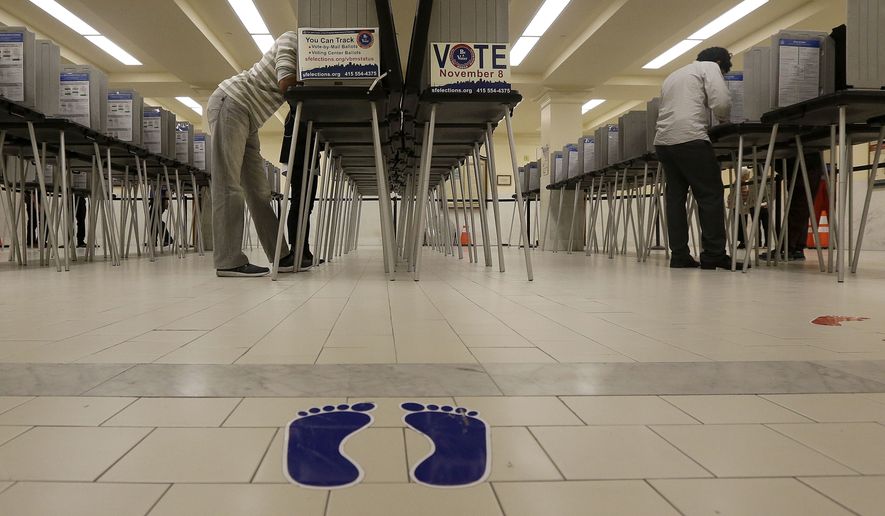California says that nearly 78 percent of its eligible residents are registered to vote, but election fraud watchdog Linda Paine insists the figure is significantly higher.
Her group, the Election Integrity Project, said in a report released Thursday that, when inactive voters are factored in, an unrealistic 98 percent of eligible Californians are actually registered.
Combine an estimated 5 million inactive registrants, who have typically died or moved out of state, with California’s lack of a voter-identification requirement, and you have a scenario ripe for polling-place scammers intent on casting illegal ballots, she said.
“It’s critical that every eligible California citizen who wants to vote can easily register,” said Ms. Paine, the six-year-old group’s founder and president. “But the state’s woefully inadequate voter list maintenance is creating misleading statistics for our lawmakers and putting the votes of lawful voting citizens at risk for voter fraud.”
Her group called it the “big dirty secret of California’s voter rolls.” But while the Golden State’s 98 percent figure is eye-popping, it isn’t necessarily an outlier when it comes to outdated voter rolls.
A 2010 Pew Center on the States issue brief found 24 million, or 1 in 8, voter registrations were no longer valid or were “significantly inaccurate”; 1.8 million deceased voters were on the rolls; and 2.75 million people were registered in more than one state.
Every state is required by law to keep missing-in-action voters on inactive status for two federal election cycles before purging them, which means that the rolls are always in flux, said David Becker, director of the Center for Election Innovation and Research.
The 98 percent registration figure? “That’s not necessarily a high number, because inactive records are records that are in a transitional phase of the list maintenance process,” said Mr. Becker.
“They don’t necessarily represent voters — they represent that California is maintaining its list, as it should, and has reason to believe those voters are no longer eligible to vote in California, most likely because they moved to another state,” he said. “It would not be a good practice to add actives and inactives together and suggest that number represents registered voters.”
But Ms. Paine said some California counties do combine active and inactive voters on the same list at their polling places on Election Day.
“All one need do is look at the posted list, memorize a name and address, repeat it to the poll worker, and receive that person’s ballot, no questions asked,” said the EIP in its press release.
The state maintains that inactive voters are not sent election materials, but Ms. Paine cited anecdotal evidence to the contrary.
“We get calls from people whose loved ones have passed away, many of them older women, and they call us saying, ‘Why would they not take my husband off the voter rolls?’” she said. “They’ve called, they’ve gone down there. People have truly gone the extra mile to get their loved ones off the voter rolls, and yet they remain year after year.”
The report said that eight of California’s 58 counties now have more than 100 percent voter-registration rates, based on figures posted Feb. 10 by Secretary of State Alex Padilla on his website — a sign that some county clerks may not be keeping their lists current.
The state has been bedeviled in recent years by flagging voter turnout, which lawmakers have sought to combat with bills lowering the voting age in some elections, making Election Day a paid holiday, and merging local and state elections.
“The state Legislature continues to pass laws to increase voter turnout,” Ms. Paine said, “but they’re looking at the wrong problem.”
• Valerie Richardson can be reached at vrichardson@washingtontimes.com.




Please read our comment policy before commenting.